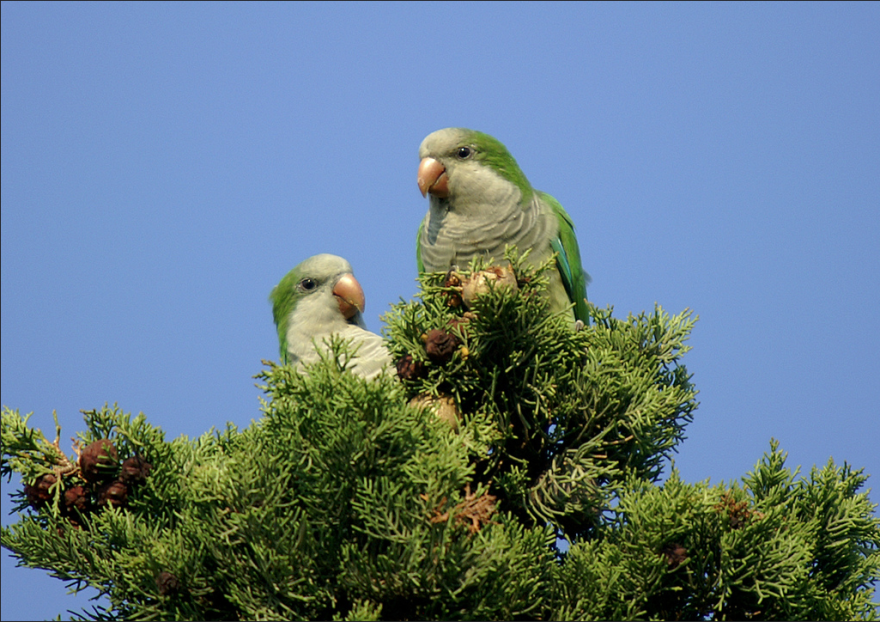Austin’s well-known as the Live Music Capital of the World, but it’s also becoming known as a place that’s running out of room. There's one neighborhood in town where old-time residents are probably going to be moved out in order to make way for new development. And it’s ruffling some feathers.
We're talking, of course, about monk parakeets. In particular, the two hundred of them that live at the University of Texas at Austin Whitaker Intramural Fields, in Central Austin on Guadalupe. Head there at dusk, and you'll see not just soccer or lacrosse scrimmages, but you'll see hundreds, if not thousands, of birds.
And the most colorful and charismatic of them are the monk parakeets. But soon they're likely going to have to move out of their longtime home.
Like a lot of people living in town, the monk parakeets of the Intramural Fields aren't native Austinites. They built nests in the light poles of the fields decades ago, and haven't left since.

“They’re not a real flashy parrot like the Macaws," says Janet Reed with Travis Audubon. "They’re not drab, either. But they make up for it with their personality. That’s one reason they’re so popular as pets.”
Reed is probably the most knowledgeable person around when it comes to these birds. She got hooked on them when she got one as a pet. She even did a research project on the birds for her PhD. She looked at how these colorful, noisy pets became wild birds in Texas.
"They were imported during the legal pet trade, as pets," Reed says. "They were popular because they were inexpensive. There were a lot of them [in Argentina], and they were considered pests there — still are.”
Argentina’s wild fowl rapidly became America’s domesticated treasure. At some point, the pet parakeets got out into the wild. Exactly how is unknown. Perhaps they were let loose on purpose, because the parakeets aren’t the easiest to live with, and they live a long time, up to twenty years in captivity.
"They’re noisy," Reed says over the squawks of dozens of parakeets at the fields. "They can get a little attitude and nippy and people get a little tired of them. So people either let them go, or they got loose accidentally.””
And some of those that did get loose survived.
“Sometime in the nineties, or maybe even before, they chose these lightpoles as a good nesting substrate,” Reed says, pointing at the towering lightpoles planted across the Intramural Field.
They snip live branches off trees to build nests atop the poles, and each one has around 6 to 8 birds per nest. Some towers have one nest; others have two.
"It’s like an apartment complex," Reed says. "They’ll build on top of each other. So that could be two nests up there — and I would say so. You can tell by finding the entrance holes, which are usually on the bottom or on the side.”
And unlike other birds that build a nest, breed, and then leave, the monk parakeets are here at the fields year-round, all the time.
The wild ones can bite, and would make terrible pets. But they’re not charmless.
“They have a lot of charisma," Reed says of the wild parakeets. "People like them. They will come and feed at people’s bird feeders. They’re a little bird with a big attitude.”
They aren’t a protected bird, because they’re not a native bird. But they're not necessarily destructive in an quasi-urban environment like the UT fields. Unless there are crops around, they don't do much damage. That's why Reed refers to them as an "introduced" species as opposed to an invasive one.
And soon, it’s likely they’re going to have to move. The University is going to refurbish the fields, and part of that involves new light poles where the current ones that house the parakeets stand. The current plan calls for moving the parakeets to a bird sanctuary. The UT Board of Regents will consider the plan in August, but moving the parakeets may turn out to be much more difficult than they imagine.
“These birds are very clever," Reed says. "They’re very smart. They’re very wary.”
Indeed, it's hard to get very close to them. When birds of prey like hawks try to attack an individual bird, other parakeets will swarm together and attack the hawk, causing it to flee.
It's not much easier for humans trying to capture the birds. Reed only managed to catch a few dozen during several years of research. At first, she used feeder traps, but the parakeets quickly caught on. Using big nets in the dark didn’t work great, either. She's not optimistic that the University's plans to capture and move the birds will be a success.
“I think what’s really going to happen is that the nest will be removed, the poles will be taken down, and the birds will move away on their own," she says.
Reed thinks the stubborn, independent Parakeets will probably just move to trees and poles nearby.
And the parakeets don’t only nest at the Intramural fields, they’re but one of several colonies in town. Reed has located nests in South Austin, out near the airport, and up at Parmer Lane.
“They are very successful at what they do, and that is building nests," she says. "And they will find a place to build their nests, regardless of what happens here.”




